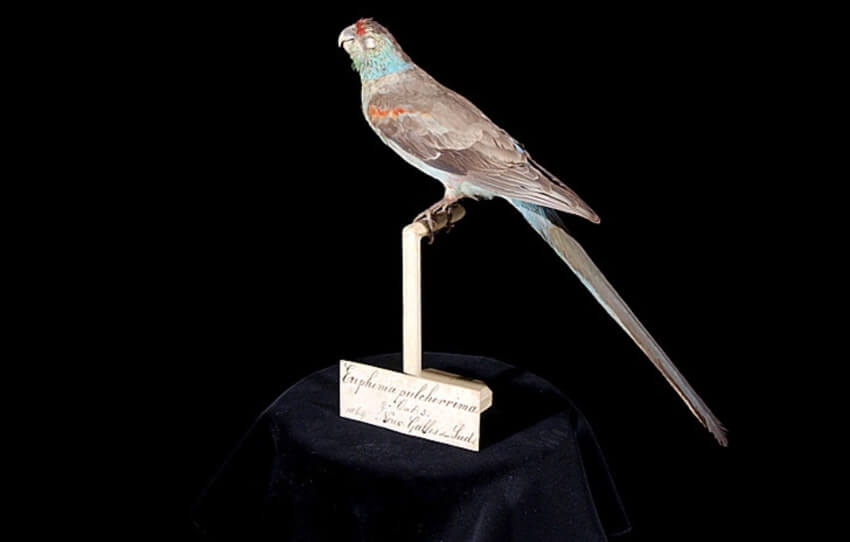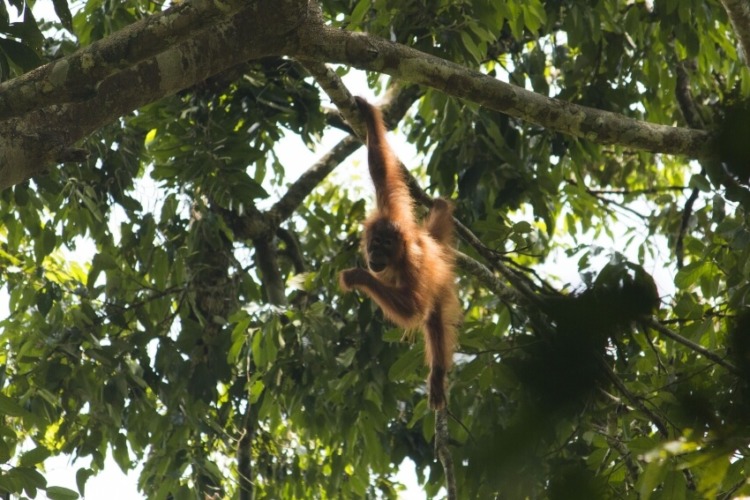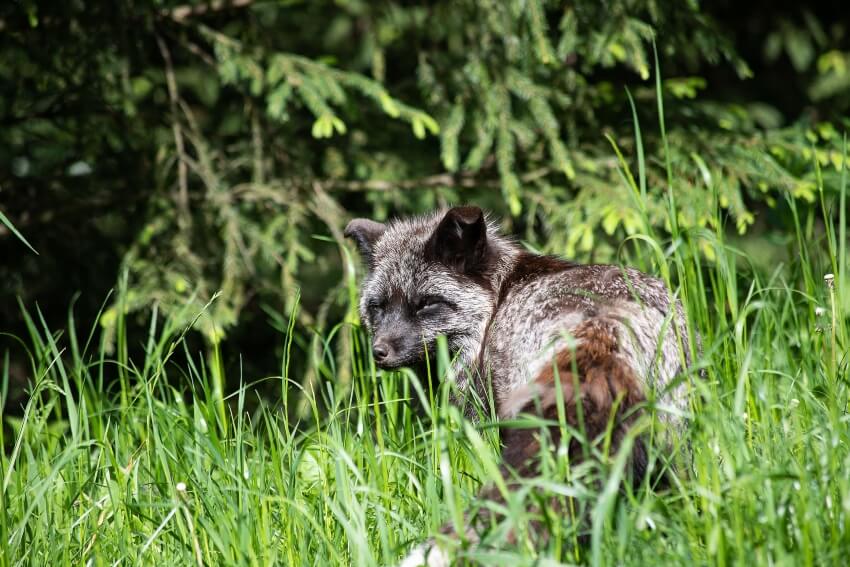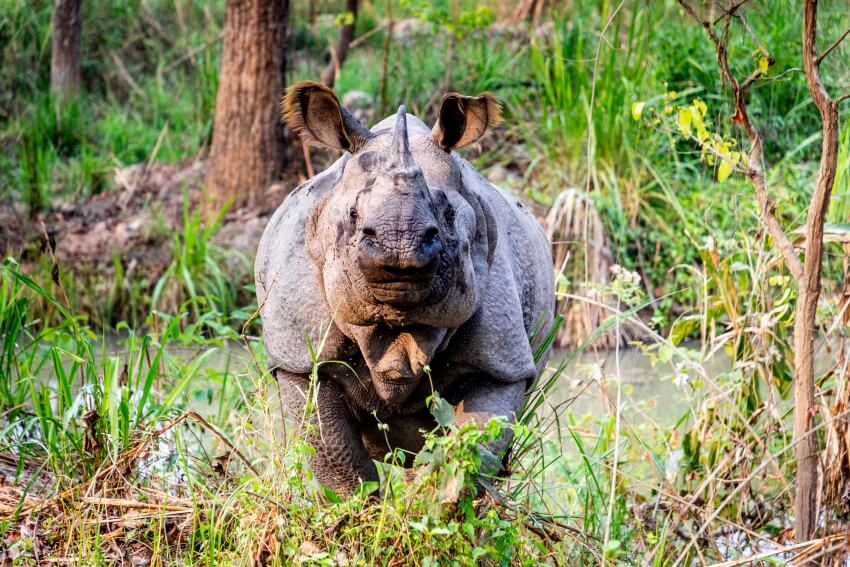How Many Animals Go Extinct Because Of Deforestation
Extinction is a natural office of any species' timeline on Earth. The nature of evolution is that the species with the most valuable advantages is normally the species most likely to survive. That means, of class, that many species fail to thrive and naturally go extinct. There are besides animals that take gone extinct due to deforestation.
But in that location have been 5 mass extinction events on Globe, and some scientists believe that we're currently in the middle of the 6th. In fact, i contempo study concluded that three-quarters of the animate being species currently living on Globe could exist extinct in the next 300 years.
The most tragic part is that this event is entirely homo-caused. From habitat destruction in the form of deforestation to the introduction of invasive predators and diseases, humans are the biggest threat to whatsoever fauna species. Only that means we also have the power to salve them.
Defining "Extinction"
The International Union for Conservation of Nature (IUCN) defines a species equally extinct when the terminal fellow member of a species has undoubtedly died. On the surface, extinction seems like a relatively simple determination. Either a species exists, or it doesn't, right?
In reality, it's a much more than complicated and nebulous concept than you might believe at outset glance. Proving beyond a reasonable doubt that there are no living members of a species in the wild requires exhaustive surveys repeated multiple times over a menstruum of several years at least.
Even then, declaring that there'south not a unmarried living member left is nearly impossible. Even if an entire species were isolated on an island of fewer than 100 foursquare miles (equally some species are), thoroughly combing the area would have years, during which time animals could drift.
The effect is that information technology takes years and sometimes even decades earlier scientists tin confidently say that every member of a species has died in the wild. The issue is complicated even further considering a species extinct in the wild may continue to exist in captivity.
The Spix'south Macaw, as you lot'll run into, has been entirely extinct in the wild for years. However, in captivity, the species is thriving as an exotic household pet. Other species may keep to exist and even reproduce in conservation zoos long after their wild relatives take gone extinct.
Until the IUCN tin say with certainty that a species has ceased to be in captivity, in the wild, or both, they may classify information technology as Critically Endangered. They may also say that a species is Possibly Extinct, a tentative subclassification that falls under Critically Endangered.
The result is that researchers may continue to allocate a species as Critically Endangered after the last member of the species has died. In September 2021, the United states alleged 23 species extinct, including the Ivory-Billed Woodpecker, which was final seen 80 years agone.
The concluding member of that species almost certainly died decades ago, yet it was just recently classified as extinct. This is but ane of many known examples of species concluding seen years agone that accept yet to exist declared extinct. There are almost certainly more examples than we know.
Fifty-fifty if a species still has a few thousand members left in the wild, though, that doesn't guarantee its survival. There must be plenty members of a species inside a specific geographic range to reproduce faster than predators, and other threats can cause them to dice.
In some cases, groups of animals are so widely spread out that they don't run across each other enough to reproduce. In others, the exterior threats to the species are so overwhelming that their extinction is inevitable.
Finally, equally you lot'll meet, species tin be brought back from extinction through captive conservation programs. These programs endeavor to reintroduce a species into the wild – but faced with the aforementioned threats that acquired their extinction in the first place, the animals oft die.
For that reason, this listing of extinct animals includes species that are definitely extinct, probably extinct, almost extinct, and inevitably on their way to extinction because the official label isn't as important as the fact that an entire species is or volition soon exist lost.
Meet Related: Animals That Have Get Extinct in the Terminal 100 Years
xiii Animal Species That Are Extinct (or Nearly Extinct) Due to Deforestation
These thirteen animal species are either already extinct or threatened to the indicate where their extinction is all but assured. For some, conservation efforts tried but failed to save them. Others were so nearly extinct when they were discovered that they were already beyond saving.
This range of scenarios demonstrates the complexity of declaring a species extinct. Information technology likewise highlights the importance of conservation efforts to forestall the ripple effect that leads a species to exist completely decimated.
The one affair that each of these species has in common is that humans are the main threat to their existence. Whether development has destroyed their habitat or the copse accept been taken as commodities, deforestation is entirely a human being problem.
The adept news is that there are still plenty of species in existence, and nosotros have the opportunity to learn from our mistakes. With the latest scientific advancements and those to come in the future, nosotros can reduce the human impact on the animals around us.
1. Formosan Clouded Leopard (Neofelis nebulosa brachyura)
Despite its proper name, the Formosan clouded leopard is a distant relative of other leopards. Large cats like the tiger, king of beasts, jaguar, and leopard are part of the Panthera genus, while overcast leopards make upwardly their own genus – Neofelis.
The Neofelis genus is further subdivided into 2 species of clouded leopard.
The mainland clouded leopard, Neofelis nebulosa, occupies the Asian mainland, while the Sunda clouded leopard, Neofelis diardi, occupies the islands of Sumatra and Kalimantan. The Formosan Clouded Leopard was a subspecies of the Mainland Clouded Leopard only found in Taiwan.
Deforestation due to logging degraded its habitat, forcing it into the mountains. The last official sighting of the Formosan Clouded Leopard was in 1983, though that photo may really have been of Neofelis diardi in Borneo.
An exhaustive survey from 2001-2004 concluded that at that place was no evidence of clouded leopards in the region, and in 2013, the Formosan clouded leopard was declared extinct. In 2019, several people reported sightings of the Formosan clouded leopard, merely those have not been confirmed.
To complicate things even further, scientists are discussing the possibility of reintroducing overcast leopards to Taiwan. The confusing status of the Formosan overcast leopard is a perfect instance of the complexities of declaring a species "extinct."
ii. Paradise Parrot (Psephotellus pulcherrimus)

Paradise parrots were a species of parakeet native to Commonwealth of australia. These birds were unusually beautiful, with their tail making upwards nigh half of their ten-inch size. Their colorful feathers were turquoise, green, orange, and brownish. Paradise parrots nested in pairs, and they occasionally made small family groups in hollowed-out termite mounds.
Due to a combination of land immigration, hunting, and predation by cats introduced by humans, what was once a relatively common bird on the Australian mainland became rarer and rarer. By 1915, the species was believed to accept been extinct. But on December 11, 1921, almost exactly 100 years ago, Cyril Jerrard of Gayndah, Australia, spotted a mating pair of paradise parrots.
Over the next twenty years or and then, there were reports of sporadic pairs of paradise parrots spotted. Though there was quite a lot of publicity around the critical status of the birds, there were few known solutions to protect them at that fourth dimension. Sadly, the last official sighting of one live was in 1927, and they are certainly extinct today.
iii. St. Helena Darter (Sympetrum dilatatum)
The St. Helena Darter was a dragonfly species owned to St. Helena Island, a tiny island in the middle of the Atlantic Sea between Brazil in South America and Angola in Africa. Information technology had no other known habitats prior to its extinction.
The exact cause of the extinction of the St. Helena Darter is unknown, only it was probable a combination of factors. St. Helena Island was colonized in the late 16th century, and habitat destruction from colonization was likely a primary cause of extinction. Other invasive aquatic species were likewise introduced, farther contributing to population loss.
The last official sighting of the St. Helena Darter was in 1963, and information technology was declared extinct some time afterward that. However, in 2011, it became credible that there had been no comprehensive surveys of St. Helena Island since 1963, and it was reclassified equally Information Deficient and later Critically Endangered (Mayhap Extinct). It was declared extinct again in 2020.
four. Hawaiian Crow (Corvus hawaiiensis)
The Hawaiian crow was once considered relatively arable on all of the Hawaiian islands, just specially in western and southeastern Hawaii. It had a call that sounded a lot like a cat's meow, along with a multifariousness of others, and was known to utilise sticks instinctively to extract food from holes in logs.
It played a critical part in the proliferation of seeds of many native Hawaiian plants. The Hawaiian crow distributed the seeds and germinated them as they passed through its digestive tract. Many such plants take no other ways of dispersing their seeds.
The colonization of the Hawaiian islands introduced multiple threats to the Hawaiian crow. Deforestation led to habitat loss, and the lack of tree cover exposed the birds to predators from to a higher place and below. Humans illegally hunted them, believing they were a threat to crops. The last members of the species were seen in the wild in 2002.
There are approximately 115 individuals in captivity. In 2016, scientists released 30 captive Hawaiian crows into the wild, hoping that the reintroduced birds would repopulate the isle. Unfortunately, just v remained four years after, and they were taken back into captivity to protect them. Scientists are currently re-evaluating the program in hopes of trying once more.
five. Pygmy Raccoon (Procyon pygmaeus)
The pygmy raccoon, also known every bit the Cozumel raccoon, lives simply on the isle of Cozumel, Mexico. They are the smallest of the Procyon genus, weighing around 7.7 pounds on average, about one-half the size of their nearest mainland relative, and take yellow rings instead of black.
Though not technically still extinct, in that location are believed to be only 189 adult pygmy raccoons in the wild on the entire 486 foursquare-mile island, and that number is declining. Pygmy raccoons confront many threats to their survival as a species, merely the almost significant threat is tourist development.
Though considered critically endangered, footling is being done to protect them from non-native predators and diseases brought by invasive species. Meanwhile, equally the tourism manufacture goes, more than and more of their habitat is beingness destroyed, and they have no mode of escaping the island.
Conservationists are considering several options to relieve the species. Preserving the mangrove forests where the pygmy raccoons live would halt the island's tourist centers from expanding further into their habitat. Conservation zoos may also brainstorm captive breeding programs.
See Related: Endangered vs Threatened vs Extinct
6. Kāmaʻo (Myadestes myadestinus)
The Kāmaʻo, besides commonly known as the Large Kaua`i Thrush, lived only on the island from which information technology got its name. They were the largest of Hawaii'due south native thrush species and were scarlet-brown with olive-colored feathers.
In the tardily 1960s, at that place were believed to be around 350 adult Kāmaʻo on the island of Kaua`i. Sadly, humans destroyed their habitat to articulate the way for farming and ranching. Deforestation combined with invasive pests and introduced predators ultimately collection them to extinction.
7. Sumatran Orangutan (Pongo abelli)

The Sumatran orangutan'southward geographic range is limited to the mountainous forests in the northern office of the island of Sumatra, Republic of indonesia. They're completely arboreal, living only in the copse and rarely coming to the ground, making them especially vulnerable to deforestation.
Though their range in one case spread across the entire island, deforestation and habitat devastation have ultimately cornered the remaining Sumatran orangutans. They're critically endangered, not yet extinct, and roughly 16,000 of them remained at the terminal survey in 2016.
Though that number sounds promising, it includes subpopulations that aren't believed to be viable long-term. In reality, in that location may exist only thirteen,000 adults remaining in the wild, and that number is on the decline.
Their primary threat is habitat loss due to deforestation. Despite conservation efforts, forest fires, land clearing, timber logging, and agricultural evolution are driving the remaining Sumatran orangutans higher and higher into the mountains.
See Related: Sumatran Tiger
8. Kākāwahie (Paroreomyza flammea)
The Kākāwahie was one time endemic to the isle of Moloka'i, Hawaii, simply was final seen in the wild in 1963. Sadly, not much is even known nearly this bird, equally it was terminal seen ordinarily in 1907 and was rare past the 1930s.
The likely causes of the kākāwahie's extinction were habitat destruction in the class of deforestation and the introduction of diseases to which they had no resistance. Surveys since 1979 take failed to locate any individuals of the species, and it was declared extinct in 1988.
The kākāwahie is a perfect instance of how long it can take to declare a species extinct, even when information technology hasn't been seen in decades. Despite concluding being seen in the 1960s, it was nearly 1990 earlier information technology was officially alleged lost.
9. Darwin'due south Play a trick on (Lycalopex fulvipes)

This fox species is owned to Chile. Though once thought to merely inhabit an island off the country's southern coast, a mainland population was discovered in a national park in 1990. Their habitat consists of former-growth forests and temperate rainforests.
Known for their short legs and bushy tails, these solitary canids pair off simply long enough to reproduce and raise their young together. Researchers accept reported several Darwin'southward foxes living upward to seven years sometime.
Though non nonetheless wholly extinct, the destruction of their habitat had reduced the total population of Darwin's foxes to equally few equally 700, and that number is decreasing. They were previously classified equally Critically Endangered until the mainland population was discovered.
They are now classified simply as endangered. Their master threats are deforestation due to forest and pulp plantations and hunting and trapping. They're also heavily plagued with disease and are expected to encounter a population turn down of 20% over the adjacent two generations.
x. Cryptic Treehunter (Cichlocolaptes mazarbarnetti)
In 2014, two ornithologists discovered a new species of bird in northeastern Brazil. They called information technology the cryptic treehunter. Its black head, chocolate-brown body, and orange tail looked similar to another known bird species, causing information technology to go undiscovered as its ain independent species.
It quickly became apparent that information technology was one of the rarest birds in the world, known to inhabit merely 2 locations in Brazil. Fifty-fifty when it was first discovered, researchers estimated there were a maximum of ten breeding pairs living, and likely fewer than that.
The species was classified as Critically Endangered, and ornithologists held out hope that they would notice more. Sadly, the forests where they lived continued to decline due to deforestation for sugarcane plantations and ranching. What niggling forest remained was scattered and remote.
Last seen in 2007, the cryptic treehunter was declared extinct in 2019. Considering of its contempo discovery and limited numbers at the time of discovery, none be in the wild. The species is almost certainly lost forever due to logging and agriculture.
11. Javan Rhinoceros (Rhinoceros sondaicus)

The rarest of the rhinoceros genus is only found in a single national park in Indonesia. They're primarily lone creatures that alive in the lowland rainforests of Indonesia. Today, their principal threat is poaching, though their numbers first dwindled because of habitat loss due to logging.
Though the population there has mostly stabilized, it has been slow to increase despite conservation efforts. They reproduce slowly, with females giving nascency only once every four to v years. Their small population size makes them particularly vulnerable to disease.
The Javan rhinoceros is not withal extinct; though its numbers are and then low, information technology'south most incommunicable to conceive of the species making a improvement. The last localized population in Vietnam went extinct in 2010, and fewer than 75 adults are living in the wild today.
Meet Related: Black Rhino
12. Mountain Glorious Torrent Frog (Taudactylus diurnus)
This species of tree frog native to Queensland, Australia, was kickoff discovered in 1966 and last seen in the wild in 1979. Though it was abundant when first discovered, it declined rapidly and was soon declared Endangered, and Critically Endangered species presently after.
Many threats contributed to the amphibians' precipitous population collapse, from habitat loss due to logging, mining, tourism, and water management combined with water contamination to invasive species and diseases that completely wiped out the Mount Glorious torrent frog.
Although it hadn't been seen in decades, scientists continued to endeavour to locate members of the species until 2004, when it was finally declared extinct.
xiii. Spix's Macaw (Cyanopsitta spixii)
The Spix's macaw was made famous in the blithe film Rio, where the main character set off to Brazil looking for the concluding wild fellow member of his species. However, by the fourth dimension that movie was released, Spix's macaws had been lost in the wild for more than ten years.
These beautiful blue birds were captured and traded as pets for decades, decimating their numbers as humans destroyed their habitats for agronomics and free energy production. There are still many living in captivity, equally pets, and in conservation programs.
Currently, a colony of captive Spix'south macaws is being prepared for release in the wild in hopes of reintroducing the species. Ii conservation areas accept been prepared specifically for their release, and scientists are hopeful that the program will succeed.
Related Resouces
- All-time Conservation Books To Read
- Ways to Save Animals Facing Extinction
- How Practise Animals Adapt to Their Environs?
Source: https://www.ourendangeredworld.com/species/animals-that-have-gone-extinct-due-to-deforestation/
Posted by: ahrenssaisent.blogspot.com

0 Response to "How Many Animals Go Extinct Because Of Deforestation"
Post a Comment